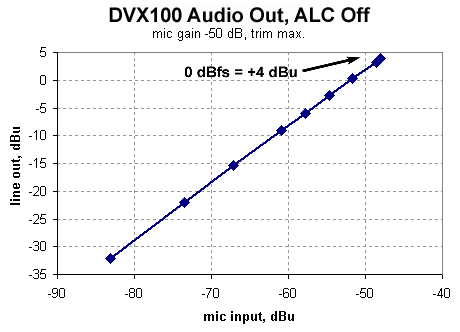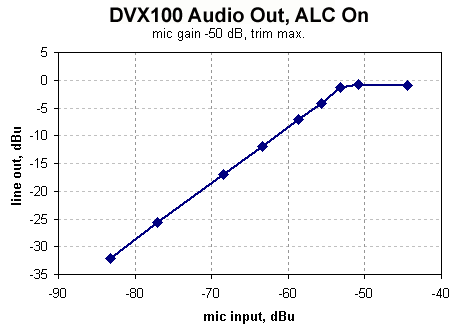
With ALC off, the mic input is linear right up to hard
clipping at 0 dBfs (full-scale). With ALC on, the input is also linear up to -5 dBfs at which point
the limiting circuit starts acting to reduce gain such that the input does not exceed -4.5 dBfs steady-state.
Below -5 dB ALC does not affect the audio response, so I prefer to leave ALC on all the time. It will not hurt your
audio if you keep your levels reasonable, and will save you from hard distortion if they aren't.
I measured the ALC-mode to be capable of dropping gain at least 25
dB to avoid clipping. I did not measure time response, this was a steady-state test. From other live event experience,
if your levels are really way too high the ALC can be momentarily overwhelmed and show some hard clipping.
The two plots below show the level of the analog line-out signal (RCA jack)
based on a range of input levels. The camera settings were mic level = -50
dB, trim control fully clockwise (+11 dB position).
In this case the total mic-in to line-out audio gain is +52 dB. If you set the trim at zero
it would be be +41 dB, and with trim at minimum, +5 dB. If you instead chose
the -60 dB mic level menu setting, and trim at +11 you could achieve a maximum mic gain of +62 dB.
For the plots I used a 1 kHz sine from a signal generator into the XLR input set to "mic" level.
I measured input and output signal levels as shown on the graphs. The digital clipping level (0 dBfs)
corresponds to +3.87 dBu line output level, so any equipment set up for the
standard +4 dBu "pro" level can handle the maximum audio output from the DVX100.
Consumer audio gear set for -10 dBV (-7.8 dBu) line level might clip on the peaks.


Back to main page